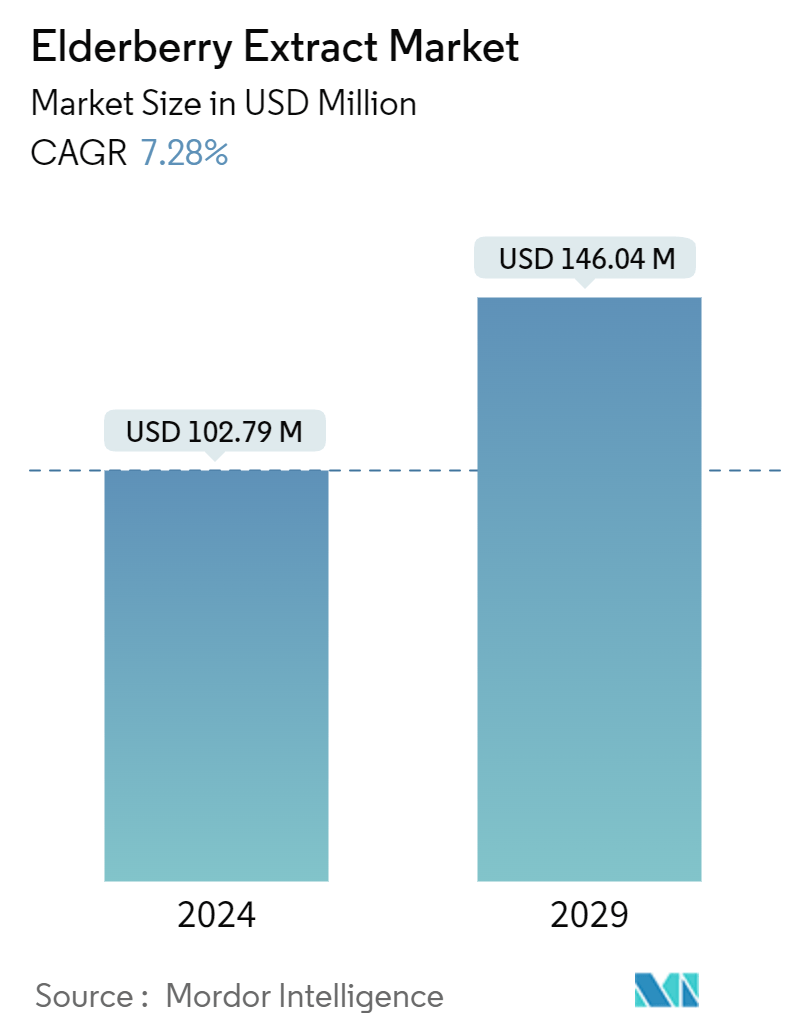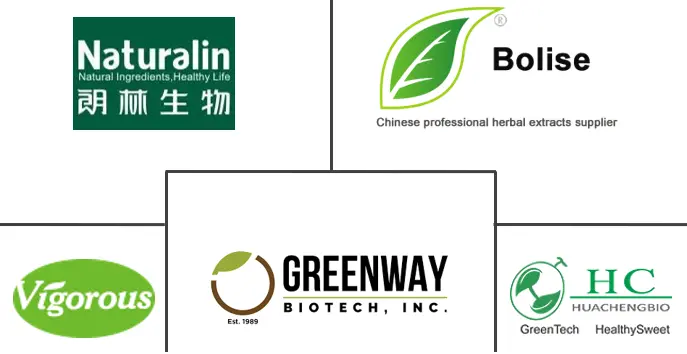Market Size of Elderberry Extract Industry

| Study Period | 2019 - 2029 |
| Market Size (2024) | USD 102.79 Million |
| Market Size (2029) | USD 146.04 Million |
| CAGR (2024 - 2029) | 7.28 % |
| Fastest Growing Market | Asia Pacific |
| Largest Market | North America |
| Market Concentration | Low |
Major Players
*Disclaimer: Major Players sorted in no particular order |
Elderberry Extract Market Analysis
The Elderberry Extract Market size is estimated at USD 102.79 million in 2024, and is expected to reach USD 146.04 million by 2029, growing at a CAGR of 7.28% during the forecast period (2024-2029).
The elderberry extracts market is witnessing growth and gaining traction worldwide. The market's growth can be attributed to the increasing demand for elderberry extracts in functional beverages, food additives, and dietary supplements. One of the primary drivers of elderberry extract's popularity is its perceived ability to support the immune system. Consumers are increasingly seeking natural ways to boost their immunity, and elderberry extract, with its high concentration of antioxidants and flavonoids, is seen as a potential solution. Studies suggest it might help reduce the duration and severity of some upper respiratory infections. Thus, increasing demand for natural and organic ingredients in the dietary supplements industry is expected to boost the demand for elderberry extract in the coming years. According to CRN, 74% of adults in the United States used dietary supplements regularly in 2023.
Furthermore, elderberry extract offers a deep purple hue, which is ideal for manufacturers seeking natural coloring alternatives in functional foods and beverages. This caters to the growing consumer preference for clean-label ingredients and avoiding artificial colors. While elderberry extract has a slightly tart taste, it balances with other ingredients. Additionally, elderberry extracts play a vital role in the cosmetic industry owing to their deep purple color and nutritional profile. According to MFDS (South Korea), the total value of cosmetics exported from South Korea was KRW 10.28 trillion in 2022. Thus, growth in various industries such as food and beverage, cosmetics and personal care, and dietary supplements is expected to propel the demand for elderberry extracts during the forecast period.
Elderberry Extract Industry Segmentation
Elderberry extract, derived from the Sambucus tree, commonly referred to as the European or black elder tree, boasts a rich nutritional profile characterized by its deep purple hue.
The elderberry extracts market is segmented by type, application, and geography. By type, the market is segmented into powder and liquid. By application, the market is segmented into functional food and beverage, dietary supplements, cosmetic and personal care, and other applications. By geography, the market is segmented into North America, Europe, Asia-Pacific, South America, and Middle East and Africa. The market sizes and forecasts have been done based on value (USD) for all the abovementioned segments.
Elderberry Extract Market Size Summary
The elderberry extract market is experiencing significant growth, driven by increasing consumer demand for natural and organic ingredients in various industries such as food and beverages, dietary supplements, and cosmetics. The extract, derived from the Sambucus nigra plant, is gaining popularity due to its perceived immune-boosting properties, attributed to its high concentration of antioxidants and flavonoids. This trend is further supported by the growing consumer preference for clean-label products, which avoid artificial additives and offer transparency in ingredient sourcing. The elderberry extract's vibrant natural purple hue also makes it an attractive alternative for manufacturers seeking natural coloring solutions. As a result, the market is poised for expansion, with elderberry extract becoming a prominent ingredient in functional foods and beverages.
The Asia-Pacific region is emerging as a key growth area for the elderberry extract market, fueled by rising health consciousness, increasing disposable incomes, and a cultural emphasis on preventative healthcare. The region's rapid urbanization and busy lifestyles are driving demand for convenient health-supporting products, such as dietary supplements in various formats. Additionally, the aging population in many Asia-Pacific countries is contributing to the growing appeal of elderberry extract, given its potential benefits for immune health. The global market is characterized by fragmentation, with both multinational and regional players actively participating. Recent product launches and innovations, such as organic and standardized elderberry extracts, highlight the ongoing efforts to meet the rising demand for natural ingredients across different markets.
Elderberry Extract Market Size - Table of Contents
-
1. MARKET DYNAMICS
-
1.1 Market Drivers
-
1.1.1 Rising Demand for Functional Food and Beverage
-
1.1.2 Increasing Consumption of Dietary Supplements
-
-
1.2 Market Restraints
-
1.2.1 Limited Supply of Elderberries
-
-
1.3 Porter's Five Forces Analysis
-
1.3.1 Threat of New Entrants
-
1.3.2 Bargaining Power of Buyers/Consumers
-
1.3.3 Bargaining Power of Suppliers
-
1.3.4 Threat of Substitute Products
-
1.3.5 Intensity of Competitive Rivalry
-
-
-
2. MARKET SEGMENTATION
-
2.1 By Type
-
2.1.1 Powder
-
2.1.2 Liquid
-
-
2.2 By Application
-
2.2.1 Functional Food and Beverage
-
2.2.2 Dietary Supplement
-
2.2.3 Cosmetic and Personal Care
-
2.2.4 Other Applications
-
-
2.3 By Geography
-
2.3.1 North America
-
2.3.1.1 United States
-
2.3.1.2 Canada
-
2.3.1.3 Mexico
-
2.3.1.4 Rest of North America
-
-
2.3.2 Europe
-
2.3.2.1 United Kingdom
-
2.3.2.2 Germany
-
2.3.2.3 France
-
2.3.2.4 Italy
-
2.3.2.5 Russia
-
2.3.2.6 Rest of Europe
-
-
2.3.3 Asia-Pacific
-
2.3.3.1 China
-
2.3.3.2 Japan
-
2.3.3.3 India
-
2.3.3.4 Australia
-
2.3.3.5 Rest of Asia-Pacific
-
-
2.3.4 South America
-
2.3.4.1 Brazil
-
2.3.4.2 Argentina
-
2.3.4.3 Rest of South America
-
-
2.3.5 Middle East and Africa
-
2.3.5.1 South Africa
-
2.3.5.2 United Arab Emirates
-
2.3.5.3 Rest of Middle East and Africa
-
-
-
Elderberry Extract Market Size FAQs
How big is the Elderberry Extract Market?
The Elderberry Extract Market size is expected to reach USD 102.79 million in 2024 and grow at a CAGR of 7.28% to reach USD 146.04 million by 2029.
What is the current Elderberry Extract Market size?
In 2024, the Elderberry Extract Market size is expected to reach USD 102.79 million.

